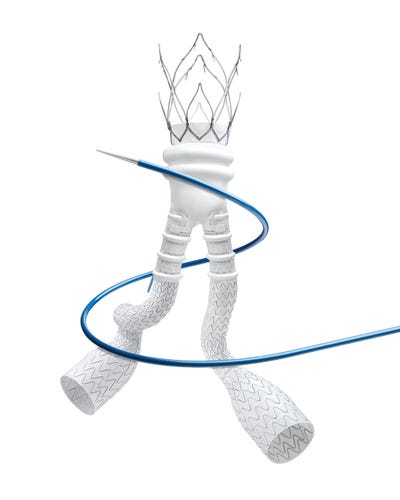This Study Could Be Huge for Women Needing EVAR
June 11, 2017
Endologix reported positive 30-day results from a study evaluating endovascular aneurysm repair in women, using a device specifically designed to better suit female anatomy compared to traditional treatment options.
Amanda Pedersen

Endologix said its Ovation System was specifically designed to better suit female anatomy compared to traditional endografts.
Underrepresentation of women in clinical trials is one of the biggest hurdles cardiovascular researchers face when evaluating a new device. This problem is particularly noticeable in the field of endovascular aneurysm repair (EVAR), where women tend to have narrower access vessels compared to men, more challenging aortic necks, and higher complication rates, making them ineligible for a lot EVAR treatment options.
But there are signs of device makers stepping up to address the issue, and Endologix is the latest example of a company leading that charge.
"Women are traditionally underrepresented in endovascular aortic trial and, broadly, you see about 10% to 12% of women represented in the big studies looking at endovascular aneurysm repair, whereas the prevalence of aneurysms in women is probably twice that," Matt Thompson, chief medical officer at Endologix, told Qmed.
The Irvine, CA-based company recently reported 30-day results from the LUCY study, which is evaluating the Ovation System, an endograft that is specifically designed to better suit female anatomy compared to traditional EVAR options. The endograft is considered ultra-low profile (14F), Thompson said.
The data showed that at least 28% more women with an abdominal aortic aneurysm (AAA) became eligible for EVAR when using the Ovation abdominal stent graft system.
"We know that women have higher growth rates of their aneurysm than men, which is dangerous. They also rupture their aneurysms at lower diameters than men, and actually, their eligibility for EVAR is lower than men, primarily because they have narrower access vessels," Thompson said.
And not only is it often more difficult to insert the endograft into the patient's smaller blood vessels leading up to the aorta, but the neck of the aneurysm - which is the area whereby the endograft has to create an effective seal just below the renal arteries - can be more challenging in women as well. It can be more angulated and it can be more diseased, Thompson said.
"This really is the first prospective study to evaluate EVAR in women, and it was done specifically using the Ovation platform, which might be thought of as being ideal in female anatomy because of the lower profile design, and also the custom design that allows good seal in the aortic neck."
The LUCY study was a consecutively enrolling, non-randomized, post-market registry. A total of 225 patients were enrolled, including 76 females in the treatment group and 149 males in the control group, at 39 U.S. sites.
30-day LUCY data · At least 28% greater EVAR eligibility for women with AAA · 1.3% major adverse events, the lowest rate reported for EVAR, compared to other contemporary, prospective, post-market registries · No deaths · No proximal endoleaks · No limb occlusion · Low readmission rate of 3.9% · 100% procedural success |
The primary endpoint of the study was the 30-day major adverse event rate, and Endologix said it will share longer term data after the patients have been followed for one year.
Thompson said the Ovation endograft leverages polymer technology, as opposed to traditional endografts that are mainly made out of metal stents and fabrics loaded into a delivery sheath. Without the metal stent work, the device is able to achieve a more custom seal in the aortic neck. That lack of metal work is also what allows the device to be much smaller.
Boston Scientific is also making strides to better understand why more women don't enroll in clinical trials, and how to knock down those barriers. According to the company, the average number of women enrolled in U.S. cardiovascular device trials between 2000 and 2007 was only one-third of the total study populations.
Boston Scientific created a new program, dubbed Women Opt-In for Heart Research (WIN-Her), which it is piloting in two recently-launched trials. As Brooke Allocco, MD, recently explained to Qmed, it's not a matter of equal gender representation, which is a common misunderstanding of the issue, she said.
"The goal is not necessarily to get to 50-50," said Allocco, vice president of clinical communications and education for the cardiac rhythm management division at Boston Scientific. "The goal is that we need to make sure we're enrolling enough women that our studies are powered to adequately assess whether these therapies are effective in women, and to be able to compare how they perform in women versus men, and to be able to do sex-specific analyses."
Beyond the gender issue, the LUCY study also highlights a growing interest in the clinical community for more personalized therapies.
"We've had a lot of feedback that personalizing aneurysm care is the direction of the future," Thompson said. "In many fields of medicine now we're seeing personalized care whereby treatment options are tailored to individual patients, rather than taking a very broad-brush approach."
Amanda Pedersen is Qmed's news editor. Contact her at [email protected].
[Image credit: Endologix Inc.]
About the Author(s)
You May Also Like


